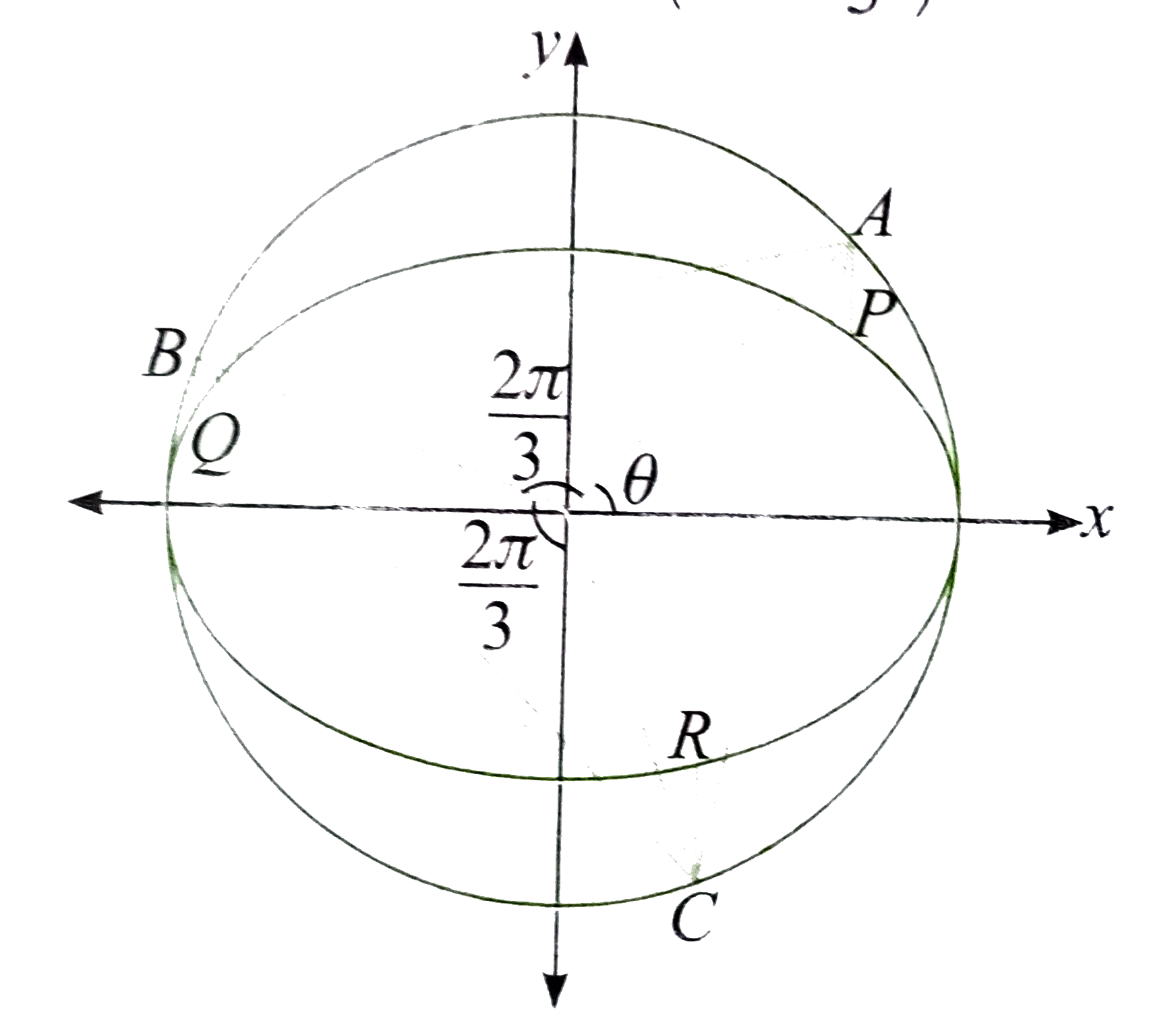show that the area of the triangle inscribed in the circle x2a2+y2b2=1 meet the ellipse respictively at P,Q,R so that P,Q,R lie on the same side of the major axis as A,B,C respictively. Prove that the normal to the ellipse drawn at the points P,Q and R are concurrent.
Let A , B and C, be the points on the cicle whose cooridnates are
A(acosθ,asinθ)
B(acos(θ+2π3),asin(θ+2π3))
C(acos(θ+4π3),asin(θ+4π3))
Hence, P≡(acosθ,bsinθ)
Q≡(acos(θ+2π3),asin(θ+2π3))
R≡(acos(θ+4π3),asin(θ+4π3))
It is given that P,Q and R are on the same side of the x-axis as A,B, and C.
So, the required nomrmals ot the ellipse at P,Q and R are
axsecθ−by cosecθ=a2−b2 (1)
axsec(θ+2π3−by cosec(θ+2π3)=a2−n2 (2)
axsec(θ+4π3−by cosec(θ+4π3)=a2−n2 (3)

Now, Δ= ∣∣
∣
∣
∣∣secθcosecθ1sec(θ+2π3)cosec(θ+2π3)1sec(θ+2π3)cosec(θ+2π3)1∣∣
∣
∣
∣∣
Multiplying R1,R2andR3, by sinθcos,θ,sin(θ+2π3)co(θ+2π3)andsin(θ+4π3) respectively, we get
Δ=1k∣∣
∣
∣
∣∣sinθcosθsin2θsin(θ+2π3)cos(θ+2π3)sin(2θ+4π3)sin(θ−2π3)cos(θ−2π3)sin(2θ−4π3)∣∣
∣
∣
∣∣
Where
k=2sinθcosθsin(θ+2π3)cos(θ−2π3)sin(θ+4π3)cos(θ+4π3)
Operating R2→R2+R3
Δ=1k∣∣
∣
∣
∣∣sinθcosθsin2θ2sinθ⋅cos.2π32cosθ⋅cos.2π32sinθ⋅cos.4π3sin(θ−2π3)cos(θ−2π3)sin(2θ−4π3)∣∣
∣
∣
∣∣
=1k∣∣
∣
∣∣sinθcosθsin2θ−sinθ−cosθ−sinθsin(θ−2π3)cos(θ−2π3)sin(2θ−4π3)∣∣
∣
∣∣
Similar Questions
Let ABC be an equilateral triangle inscribed in the circle x2+y2=a2 . Suppose pendiculars from A, B, C to the ellipse x2a2+y2b2=1,(a>b) meets the ellipse respectivelily at P, Q, R so that P, Q , R lies on same side of major axis as A, B, C respectively. Prove that the normals to the ellipse drawn at the points P Q nad R are concurrent.
View SolutionP and Q are corresponding points on the ellipse x2a2+y2b2=1 and the auxiliary circle respectively . The normal at P to the elliopse meets CQ at R. where C is the centre of the ellipse Prove that CR = a +b
View SolutionIf the normal at any point P on ellipse x2a2+y2b2=1 meets the auxiliary circle at Q and R such that ∠QOR=90∘ where O is centre of ellipse, then
View SolutionThe tangent and normal to the ellipse x2+4y2=4 at a point P(θ) on it meets the major axis in Q and R respectively. If 0<θ<π2 and QR=2 then show that θ=
View SolutionIn ΔPQR, if PQ=QR and L,M and N are the mid-points of the sides PQ,QR and RP respectively. Prove that LN=MN.
View SolutionThe tangent at point P on the ellipse x2a2+y2b2=1 cuts the minor axis in Q and PR is drawn perpendicular to the minor axis. If C is the centre of the ellipse, then CQ⋅CR=
View SolutionIf normal at any poin P on the ellipse x2a2+y2b2=1(a>b>0) meets the major and minor axes at Q and R, respectively, so that 3PQ=2PR, then find the eccentricity of ellipse
View SolutionLet P be a point on the ellipse x2a2+y2b2=1,0<b<a and let the line parallel to y-axis passing through P meet the circle x2+y2=a2 at the point Q such that P and Q are on the same side of x-axis. For two positive real numbers r and s, find the locus of the point R on PQ such that PR:RQ=r:s and P varies over the ellipse.
View SolutionA normal inclined at 45∘ to the axis of the ellipse x2a2+y2b2=1 is drawn. It meets the x-axis & the y-axis in P & Q respectively. If C is the centre of the ellipse, show that the area of triangle CPQ is (a2−b2)22(a2+b2) sq units
View SolutionThe normals at P, Q, R on the parabola y2=4ax meet in a point on the line y=c. Prove that the sides of the triangle PQR touch the parabola x2=2cy.
View Solution

